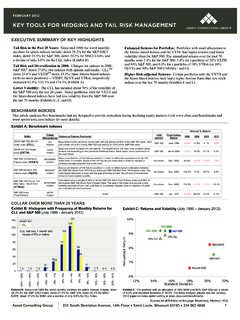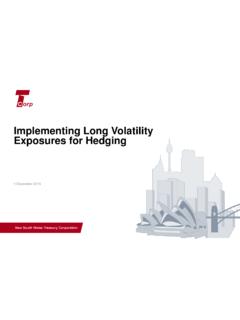Transcription of Understanding Stock Options - Cboe
1 Understanding Stock Of Exchange-Traded Compared To Common Is An 1994, The Options Clearing S. LaSalle StreetSuite 2400 Chicago, IL 60605 USA1-800-537-4258(312) 322-6200 All Rights are financial instruments that can provide you, the individual investor, withthe flexibility you need in almost any investment situation you might give you Options . You're not just limited to buying, selling or staying out ofthe market. With Options , you can tailor your position to your own situation and stockmarket outlook. Consider the following potential benefits of Options : You can protect Stock holdings from a decline in market price You can increase income against current Stock holdings You can prepare to buy Stock at a lower price You can position yourself for a big market move even when you don't know which way prices will move You can benefit from a Stock price's rise or fall without incurring the cost of buying or selling the stockoutrightA Stock option is a contract which conveys to its holder the right, but not theobligation, to buy or sell shares of the underlying security at a specified price on orbefore a given date.
2 After this given date, the option ceases to exist. The seller of anoption is, in turn, obligated to sell (or buy) the shares to (or from) the buyer of theoption at the specified price upon the buyer's are currently traded on the following exchanges: The American StockExchange, Inc. (AMEX), the Chicago Board Options Exchange, Inc. ( cboe ), the NewYork Stock Exchange, Inc. (NYSE), The Pacific Stock Exchange, Inc. (PSE), and thePhiladelphia Stock Exchange, Inc. (PHLX). Like trading in stocks , option trading isregulated by the Securities and Exchange Commission (SEC).The purpose of this publication is to provide an introductory Understanding of stockoptions and how they can be used. Options are also traded on indexes (AMEX, cboe ,NYSE, PHLX, PSE), on Treasury securities ( cboe ), and on foreign currencies(PHLX); information on these option products is not included in this document but canbe obtained by contacting the appropriate exchange (see pages 40 and 41 for addressesand phone numbers).
3 These exchanges which trade Options seek to providecompetitive, liquid, and orderly markets for the purchase and sale of standardizedoptions. All option contracts traded on securities exchanges are issued,guaranteed and cleared by The Options Clearing Corporation (OCC). OCC is aregistered clearing corporation with the SEC and has received a 'AAA' credit ratingfrom Standard & Poor's Corporation. The 'AAA' credit rating relates to OCC's abilityto fulfill its obligations as counter-party for Options introductory document should be read in conjunction with the basic optiondisclosure document, titled Characteristics and Risks of Standardized Options , whichoutlines the purposes and risks of option transactions. Despite their many benefits, Options are not suitable for all investors.
4 Individuals should not enter into optiontransactions until they have read and understood the risk disclosure document whichcan be obtained here and from their broker, any of the Options exchanges, or OCC. Itmust be noted that, despite the efforts of each exchange to provide liquid markets,under certain conditions it may be difficult or impossible to liquidate an optionposition. Please refer to the disclosure document for further discussion on this addition, margin requirements, transaction and commission costs, and taxramifications of buying or selling Options should be discussed thoroughly with abroker and/or tax advisor before engaging in option Of Exchange-Traded OptionsOrderly, Efficient, and Liquid Flexibility.. Limited Contract Performance.
5 These are the major benefits of Options traded onsecurities exchanges the history of Options extends several centuries, it was not until 1973 thatstandardized, exchange-listed and government regulated Options became available. Inonly a few years, these Options virtually displaced the limited trading in over-the-counter Options and became an indispensable tool for the securities , Efficient and Liquid MarketsStandardized option contracts provide orderly, efficient, and liquid option under special circumstances, all Stock option contracts are for 100 shares of theunderlying Stock . The strike price of an option is the specified share price at which theshares of Stock will be bought or sold if the buyer of an option, or the holder, exerciseshis option.
6 Strike prices are listed in increments of , 5, or 10 points, depending onthe market price of the underlying security, and only strike prices a few levels aboveand below the current market price are traded. Other than for long-term Options , orLEAPS, which are discussed below, at any given time a particular option can bebought with one of four expiration dates (see tables in Appendix). As a result of thisstandardization, option prices can be obtained quickly and easily at any time duringtrading hours. Additionally, closing option prices (premiums) for exchange-tradedoptions are published daily in many newspapers. Option prices are set by buyers andsellers on the exchange floor where all trading is conducted in the open, competitivemanner of an auction are an extremely versatile investment tool.
7 Because of their uniquerisk/reward structure, Options can be used in many combinations with other optioncontracts and/or other financial instruments to create either a hedged or speculativeposition. Some basic strategies are described in a later Stock option allows you to fix the price, for a specific period of time, at which youcan purchase or sell 100 shares of Stock for a premium (price) which is only apercentage of what you would pay to own the Stock outright. That leverage means thatby using Options you may be able to increase your potential benefit from a Stock 'sprice example, to own 100 shares of a Stock trading at $50 per share would cost $5, the other hand, owning a $5 call option with a strike price of $50 would give youthe right to buy 100 shares of the same Stock at any time during the life of the optionand would cost only $500.
8 Remember that premiums are quoted on a per share basis;thus a $5 premium represents a premium payment of $5 x 100, or $500, per optioncontract. Market's assume that one month after the option was purchased, the stockprice has risen to $55. The gain on the Stock investment is $500, or 10%. However, forthe same $5 increase in the Stock price, the call option premium might increase to $7,For a return of $200, or 40%. Although the dollar amount gained on the stockinvestment is greater than the option investment , the percentage return is much greaterwith Options than with Stock . Leverage also has downside implications. If the stockdoes not rise as anticipated or falls during the life of the option, leverage will magnifythe investment 's percentage loss.
9 For instance, if in the above example the Stock hadinstead fallen to $40, the loss on the Stock investment would be $1,000 (or 20%). Forthis $10 decrease in Stock price, the call option premium might decrease to $2resulting in a loss of $300 (or 60%). You should take note, however, that as an optionbuyer, the most you can lose is the premium amount you paid for the Risk For BuyerUnlike other investments where the risks may have no limit, Options offer a knownrisk to buyers. An option buyer absolutely cannot lose more than the price of theoption, the premium. Because the right to buy or sell the underlying security at aspecific price expires on a given date, the option will expire worthless if the conditionsfor profitable exercise or sale of the contract are not met by the expiration date.
10 Anuncovered option seller (sometimes referred to as the writer of an option), on the otherhand, may face unlimited Contract PerformanceAn option holder is able to look to the system created by OCC's Rules which includesthe brokers and Clearing Members involved in a particular option transaction and tocertain funds held by OCC - rather than to any particular option writer forperformance. Prior to the existence of option exchanges and OCC, an option holderwho wanted to exercise an option depended on the ethical and financial integrity of thewriter or his brokerage firm for performance. Furthermore, there was no convenientmeans of closing out one's position prior to the expiration of the , as the common clearing entity for all exchange traded option transactions,resolves these difficulties.
















